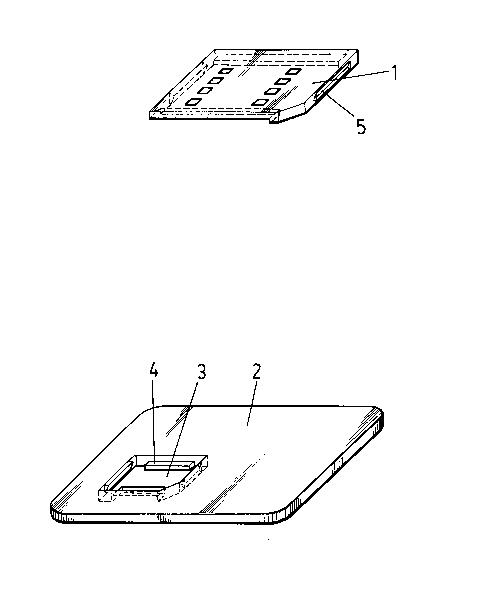Une partie des informations de ce site Web a été fournie par des sources externes. Le gouvernement du Canada n'assume aucune responsabilité concernant la précision, l'actualité ou la fiabilité des informations fournies par les sources externes. Les utilisateurs qui désirent employer cette information devraient consulter directement la source des informations. Le contenu fourni par les sources externes n'est pas assujetti aux exigences sur les langues officielles, la protection des renseignements personnels et l'accessibilité.
L'apparition de différences dans le texte et l'image des Revendications et de l'Abrégé dépend du moment auquel le document est publié. Les textes des Revendications et de l'Abrégé sont affichés :
| (12) Demande de brevet: | (11) CA 2158530 |
|---|---|
| (54) Titre français: | CARTE A PUCE POUR LE TELEPHONE ET SERVICES SIMILAIRES |
| (54) Titre anglais: | INTELLIGENT CARD USEFUL IN TELEPHONES AND THE LIKE |
| Statut: | Réputée abandonnée et au-delà du délai pour le rétablissement - en attente de la réponse à l’avis de communication rejetée |
| (51) Classification internationale des brevets (CIB): |
|
|---|---|
| (72) Inventeurs : |
|
| (73) Titulaires : |
|
| (71) Demandeurs : |
|
| (74) Agent: | RICHES, MCKENZIE & HERBERT LLP |
| (74) Co-agent: | |
| (45) Délivré: | |
| (22) Date de dépôt: | 1995-09-18 |
| (41) Mise à la disponibilité du public: | 1996-03-20 |
| Requête d'examen: | 2002-09-06 |
| Licence disponible: | S.O. |
| Cédé au domaine public: | S.O. |
| (25) Langue des documents déposés: | Anglais |
| Traité de coopération en matière de brevets (PCT): | Non |
|---|
| (30) Données de priorité de la demande: | ||||||
|---|---|---|---|---|---|---|
|
Two types of subscriber identification modules (SIM)
exist in the field of mobile telephony, one type
conforming to the conventional ISO 7810/13/16 format and
the other type to the PrENV 1375-2 European pre-standard
format. In particular, the latter type uses a small
identification module on its own, and the first type uses
such module integrally with a larger plastic card. The
intelligent card of the invention is comprised by the
combination of a module (1) conforming to the European
pre-standard and a laminar sheet (2) having a window (3)
capable of housing therein said module (1) snugly to turn
into a chip card conforming to ISO standards, being
particular in that tonguing and grooving means (4-5) are
established between the edges of the module (1) and the
edges of the window (3) allowing said parts to be easily
coupled to and uncoupled from each other, to be used
jointly or separately, as required at each particular
instance.
Note : Les revendications sont présentées dans la langue officielle dans laquelle elles ont été soumises.
Note : Les descriptions sont présentées dans la langue officielle dans laquelle elles ont été soumises.

2024-08-01 : Dans le cadre de la transition vers les Brevets de nouvelle génération (BNG), la base de données sur les brevets canadiens (BDBC) contient désormais un Historique d'événement plus détaillé, qui reproduit le Journal des événements de notre nouvelle solution interne.
Veuillez noter que les événements débutant par « Inactive : » se réfèrent à des événements qui ne sont plus utilisés dans notre nouvelle solution interne.
Pour une meilleure compréhension de l'état de la demande ou brevet qui figure sur cette page, la rubrique Mise en garde , et les descriptions de Brevet , Historique d'événement , Taxes périodiques et Historique des paiements devraient être consultées.
| Description | Date |
|---|---|
| Inactive : CIB expirée | 2009-01-01 |
| Demande non rétablie avant l'échéance | 2004-09-20 |
| Le délai pour l'annulation est expiré | 2004-09-20 |
| Réputée abandonnée - omission de répondre à un avis sur les taxes pour le maintien en état | 2003-09-18 |
| Inactive : Dem. traitée sur TS dès date d'ent. journal | 2002-09-26 |
| Inactive : Renseign. sur l'état - Complets dès date d'ent. journ. | 2002-09-26 |
| Lettre envoyée | 2002-09-26 |
| Exigences relatives à la révocation de la nomination d'un agent - jugée conforme | 2002-09-12 |
| Exigences relatives à la nomination d'un agent - jugée conforme | 2002-09-12 |
| Inactive : Lettre officielle | 2002-09-12 |
| Inactive : Lettre officielle | 2002-09-12 |
| Exigences pour une requête d'examen - jugée conforme | 2002-09-06 |
| Toutes les exigences pour l'examen - jugée conforme | 2002-09-06 |
| Demande publiée (accessible au public) | 1996-03-20 |
| Date d'abandonnement | Raison | Date de rétablissement |
|---|---|---|
| 2003-09-18 |
Le dernier paiement a été reçu le 2002-08-19
Avis : Si le paiement en totalité n'a pas été reçu au plus tard à la date indiquée, une taxe supplémentaire peut être imposée, soit une des taxes suivantes :
Veuillez vous référer à la page web des taxes sur les brevets de l'OPIC pour voir tous les montants actuels des taxes.
| Type de taxes | Anniversaire | Échéance | Date payée |
|---|---|---|---|
| TM (demande, 2e anniv.) - générale | 02 | 1997-09-18 | 1997-09-18 |
| TM (demande, 3e anniv.) - générale | 03 | 1998-09-18 | 1998-08-05 |
| TM (demande, 4e anniv.) - générale | 04 | 1999-09-20 | 1999-09-17 |
| TM (demande, 5e anniv.) - générale | 05 | 2000-09-18 | 2000-08-09 |
| TM (demande, 6e anniv.) - générale | 06 | 2001-09-18 | 2001-09-11 |
| TM (demande, 7e anniv.) - générale | 07 | 2002-09-18 | 2002-08-19 |
| Requête d'examen - générale | 2002-09-06 |
Les titulaires actuels et antérieures au dossier sont affichés en ordre alphabétique.
| Titulaires actuels au dossier |
|---|
| FABRICA NACIONAL DE MONEDA Y TIMBRE |
| Titulaires antérieures au dossier |
|---|
| FERNANDO PISONERO MONTES |
| MANUEL FERNANDEZ PEREZ |
| SANCHES CARLOS MONTEZ |